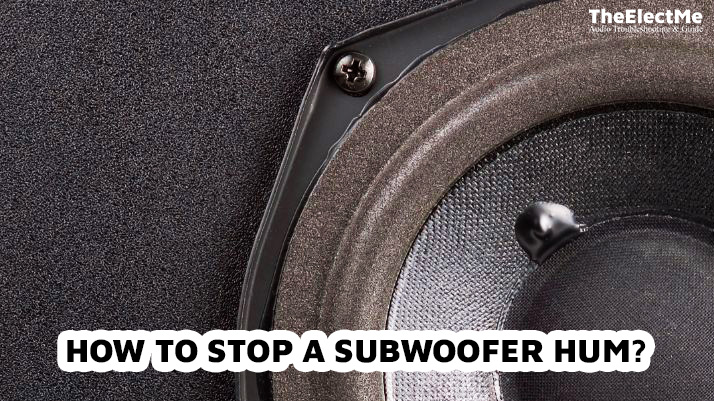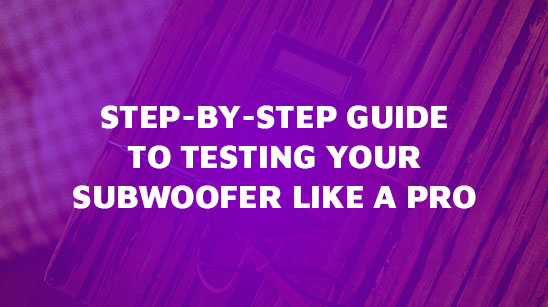A subwoofer hum can be a frustrating issue for any audio enthusiast. That annoying low-frequency noise is constantly present, even when no music or sound is playing. It can also be a sign of potential equipment problems.

How to stop a subwoofer hum? Any audio system, no matter how advanced, can experience this issue. To help you solve this problem, follow this troubleshooting guide. Your subwoofer will return to providing crisp, clear sound in no time.
How To Stop A Subwoofer Hum With A Simple Technique?
When you first notice a subwoofer hum, don’t panic. It might be due to a straightforward issue that can easily be fixed. Here’s a simple technique or method to help you stop a subwoofer hum.
1. Change the polarity of the subwoofer’s connection
A polarity issue can cause a subwoofer hum. Polarity refers to the positive and negative connections on your subwoofer, which must match those on your amplifier or receiver. If these connections are opposite, it can cause interference and result in a hum.
To change the polarity of your subwoofer’s connection, you must switch the positive and negative wires connected to your subwoofer. This can quickly be done by disconnecting and reconnecting the wires. Make sure to follow the specific instructions for your subwoofer model.
2. Check all cables and connections
Another common cause of a subwoofer hum is loose or faulty cables and connections. Follow these steps to check all your cables and connections:
- Turn off your subwoofer and amplifier/receiver.
- Carefully inspect all the cables connected to your subwoofer, amplifier/receiver, and other audio sources.
- Look for any loose or damaged cables. If you find any, tighten them or replace them if necessary.
- Check all the connection points for dust, debris, or corrosion. Clean them if needed using a soft cloth.
- Once everything is in order, reconnect all the cables and make sure they are securely plugged in.
When checking your cables and connections, ensuring they are connected to the correct input/output ports is essential. Otherwise, it can also cause a subwoofer hum.
3. Use a ground loop isolator
A ground loop isolator is a device that helps eliminate unwanted electrical noise, including a subwoofer hum. How does it work? It breaks the ground connection between your subwoofer and other audio equipment. The result is a cleaner, noise-free sound.
To use a ground loop isolator, connect it between your subwoofer and amplifier/receiver. After the connection is made, turn on your subwoofer and audio equipment. If the hum persists, try using a different ground loop isolator.
You can find ground loop isolators at most audio equipment stores, which are relatively inexpensive.
4. Check for interference
Interference from other electronic devices can also cause a subwoofer hum. This can include Wi-Fi routers, cell phones, or even appliances like refrigerators. To check for interference, start by turning off all electronic devices in the room and see if the hum disappears. If it does, then there is likely an interference issue.
To prevent interference, try moving your subwoofer away from other electronic devices. You can also use shielded cables to reduce the chance of interference.
5. Consider the location of your subwoofer
The location of your subwoofer can also contribute to a hum. Placing it too close to walls or corners can cause sound reflections and interference, resulting in a hum. Ideally, your subwoofer should be placed away from walls and other large objects.
Consider using a subwoofer isolation pad to absorb vibrations and reduce the chance of interference. You can also experiment with different placement options to find the best spot for your subwoofer. Can you place the subwoofer on a shelf? Yes, with the right techniques, you can place it on a shelf.
When to seek Professional Help?
If the above methods do not solve your subwoofer hum issue, it may be time to seek professional help. A technician knows audio equipment. They can troubleshoot and identify any underlying issues causing the hum.
Additionally, they can also help with the proper setup and placement of your subwoofer to prevent future hums. Don’t hesitate to seek professional help if needed, as it can save you time and frustration in the long run.
You know how to solve the pesky subwoofer hum; let’s explore why it occurs in the first place. Understanding the causes can also help prevent future occurrences.

Root Causes of a Subwoofer Hum
There are several potential causes for a subwoofer hum, including:
- A faulty or damaged subwoofer or amplifier/receiver
- Unbalanced power sources
- Grounding issues in the electrical system
- Improper grounding of audio equipment
These are not the only causes, but they are the most common.
Identifying and addressing these root causes can help prevent a subwoofer hum from occurring in the future. Power supply problems can lead to buzzing in the subwoofer. Regular maintenance and proper setup of your audio equipment can also help prevent issues.
Conclusion – How To Stop A Subwoofer Hum?
To sum up, a subwoofer hum is a common issue many audio enthusiasts face. However, it can quickly be resolved with the above simple techniques and tips. From changing the polarity of your subwoofer connection to using a ground loop isolator, there are various methods you can try.
Remember also to consider the location of your subwoofer and check for any interference from other electronic devices. If all else fails, don’t hesitate to seek professional help. Understanding the root causes of a subwoofer hum can also help prevent future occurrences.
You can enjoy a clean and crisp sound from your subwoofer with proper maintenance and setup.



